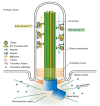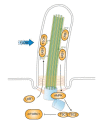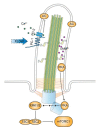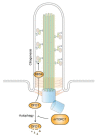Reciprocal Regulation between Primary Cilia and mTORC1
- PMID: 32604881
- PMCID: PMC7349257
- DOI: 10.3390/genes11060711
Reciprocal Regulation between Primary Cilia and mTORC1
Abstract
In quiescent cells, primary cilia function as a mechanosensor that converts mechanic signals into chemical activities. This unique organelle plays a critical role in restricting mechanistic target of rapamycin complex 1 (mTORC1) signaling, which is essential for quiescent cells to maintain their quiescence. Multiple mechanisms have been identified that mediate the inhibitory effect of primary cilia on mTORC1 signaling. These mechanisms depend on several tumor suppressor proteins localized within the ciliary compartment, including liver kinase B1 (LKB1), AMP-activated protein kinase (AMPK), polycystin-1, and polycystin-2. Conversely, changes in mTORC1 activity are able to affect ciliogenesis and stability indirectly through autophagy. In this review, we summarize recent advances in our understanding of the reciprocal regulation of mTORC1 and primary cilia.
Keywords: AMPK; LKB1; Tsc2; autophagy; ciliogenesis; mTOR; mTORC1; polycystin-1; primary cilia.
Conflict of interest statement
The authors declare no conflict of interest.
Figures




Similar articles
-
Tumor Suppressor Folliculin Regulates mTORC1 through Primary Cilia.J Biol Chem. 2016 May 27;291(22):11689-97. doi: 10.1074/jbc.M116.719997. Epub 2016 Apr 12. J Biol Chem. 2016. PMID: 27072130 Free PMC article.
-
Primary cilia regulate mTORC1 activity and cell size through Lkb1.Nat Cell Biol. 2010 Nov;12(11):1115-22. doi: 10.1038/ncb2117. Epub 2010 Oct 24. Nat Cell Biol. 2010. PMID: 20972424 Free PMC article.
-
MITF-MIR211 axis is a novel autophagy amplifier system during cellular stress.Autophagy. 2019 Mar;15(3):375-390. doi: 10.1080/15548627.2018.1531197. Epub 2018 Oct 16. Autophagy. 2019. PMID: 30290719 Free PMC article.
-
Crosstalk of Hedgehog and mTORC1 Pathways.Cells. 2020 Oct 18;9(10):2316. doi: 10.3390/cells9102316. Cells. 2020. PMID: 33081032 Free PMC article. Review.
-
mTORC1 as the main gateway to autophagy.Essays Biochem. 2017 Dec 12;61(6):565-584. doi: 10.1042/EBC20170027. Print 2017 Dec 12. Essays Biochem. 2017. PMID: 29233869 Free PMC article. Review.
Cited by
-
A single-cell atlas of the miracidium larva of Schistosoma mansoni reveals cell types, developmental pathways, and tissue architecture.Elife. 2024 Aug 27;13:RP95628. doi: 10.7554/eLife.95628. Elife. 2024. PMID: 39190022 Free PMC article.
-
Renal Ciliopathies: Sorting Out Therapeutic Approaches for Nephronophthisis.Front Cell Dev Biol. 2021 May 13;9:653138. doi: 10.3389/fcell.2021.653138. eCollection 2021. Front Cell Dev Biol. 2021. PMID: 34055783 Free PMC article. Review.
-
AMBRA1 p.Gln30Arg Mutation, Identified in a Cowden Syndrome Family, Exhibits Hyperproliferative Potential in hTERT-RPE1 Cells.Int J Mol Sci. 2022 Sep 22;23(19):11124. doi: 10.3390/ijms231911124. Int J Mol Sci. 2022. PMID: 36232425 Free PMC article.
-
Recent advances in the understanding of cilia mechanisms and their applications as therapeutic targets.Front Mol Biosci. 2023 Sep 14;10:1232188. doi: 10.3389/fmolb.2023.1232188. eCollection 2023. Front Mol Biosci. 2023. PMID: 37780208 Free PMC article. Review.
-
A loss of primary cilia by a reduction in mTOR signaling correlates with age-related deteriorations in condylar cartilage.Geroscience. 2024 Dec;46(6):5995-6007. doi: 10.1007/s11357-024-01143-x. Epub 2024 Mar 25. Geroscience. 2024. PMID: 38526843 Free PMC article.
References
Publication types
MeSH terms
Substances
Grants and funding
LinkOut - more resources
Full Text Sources
Miscellaneous

